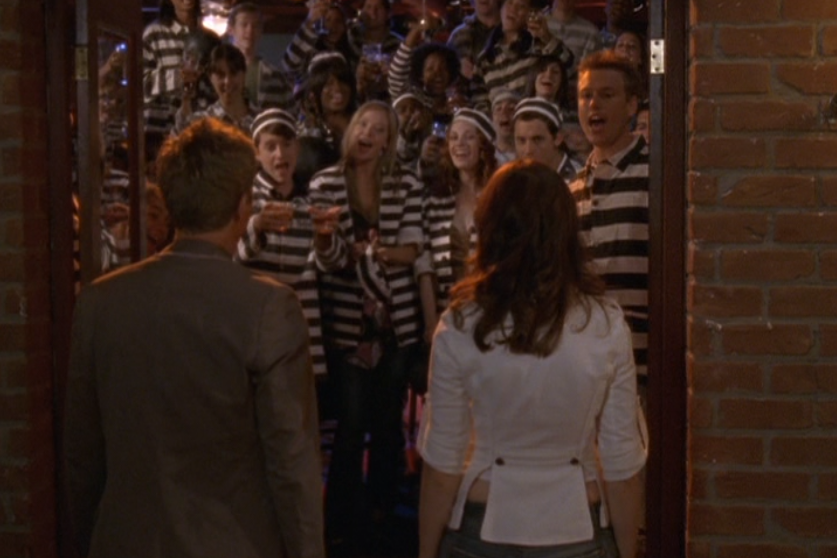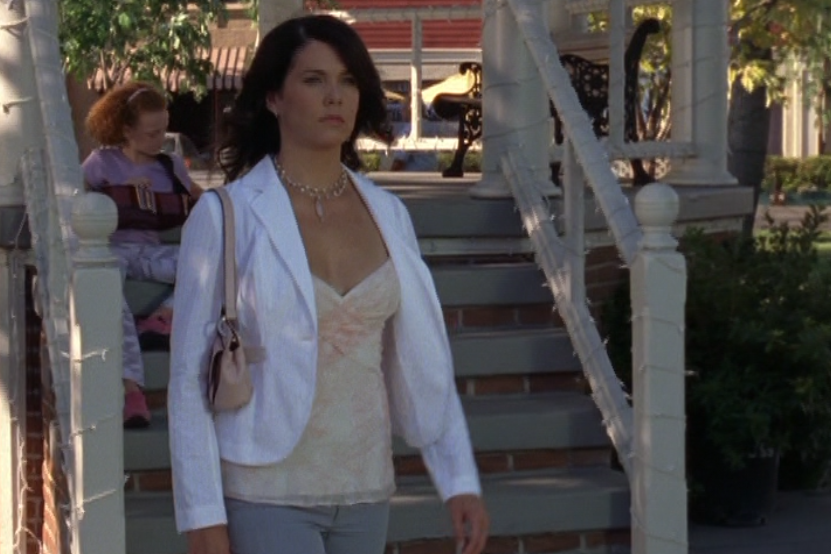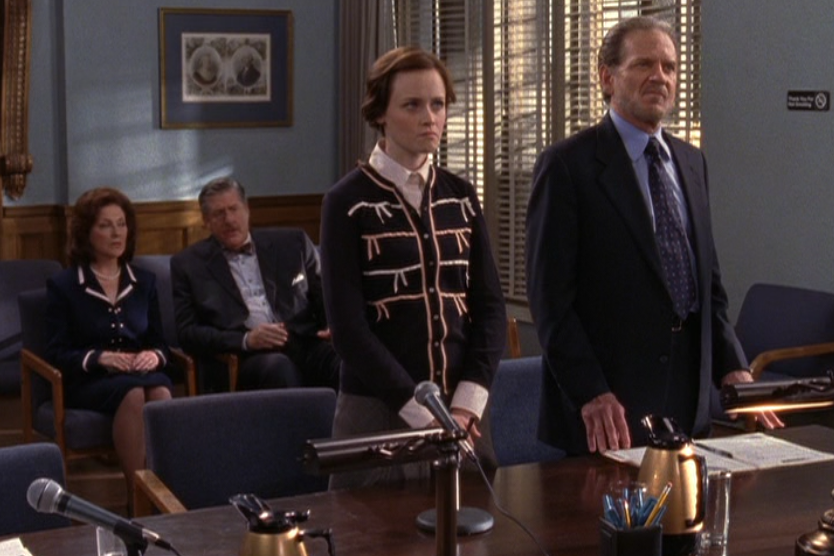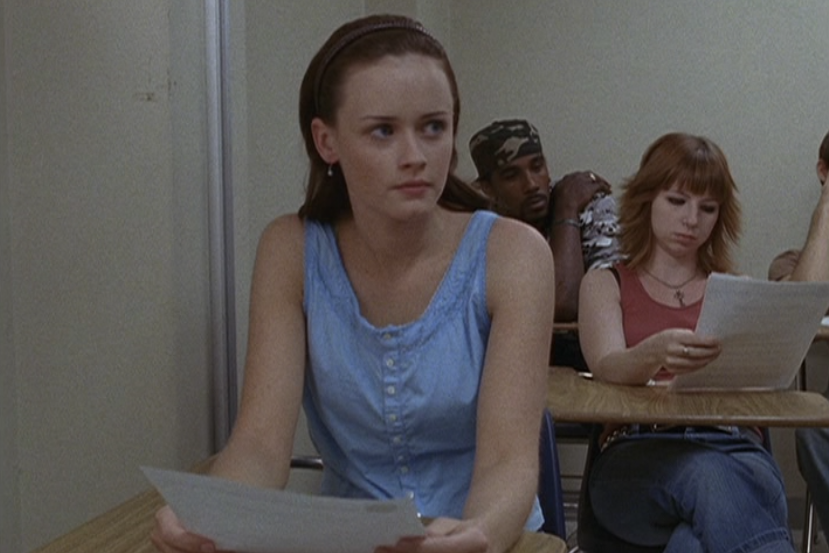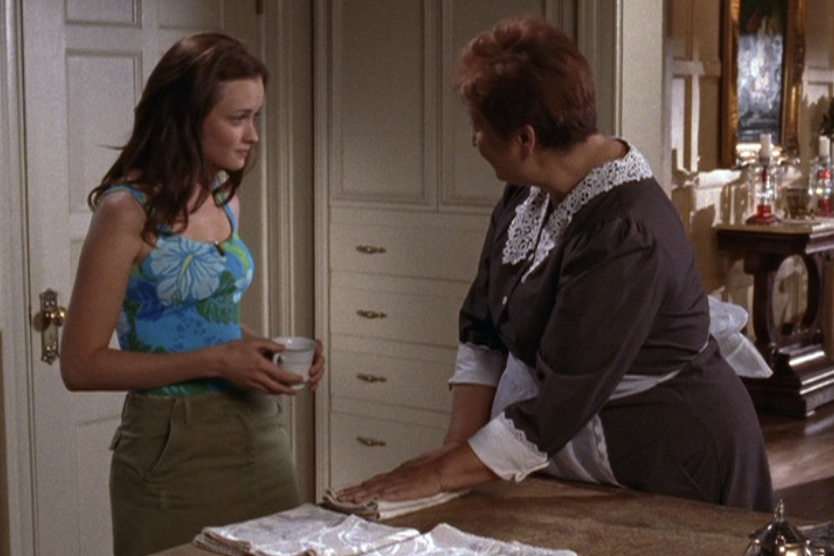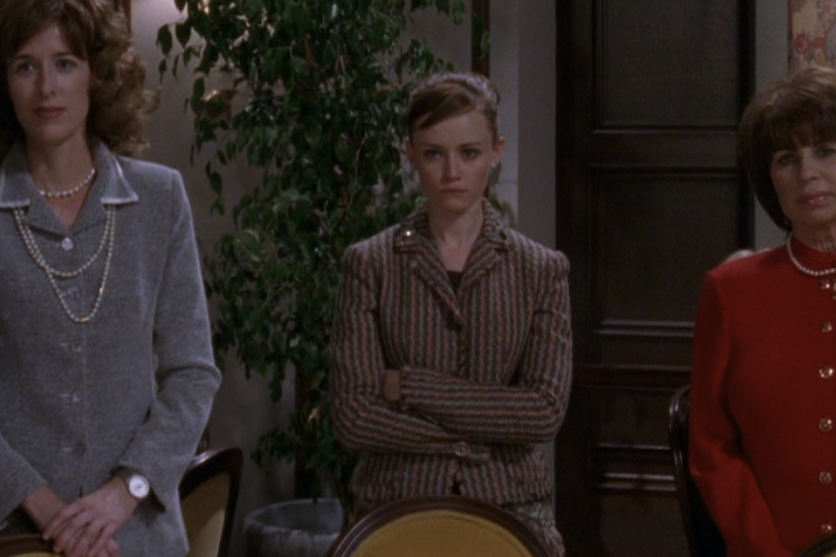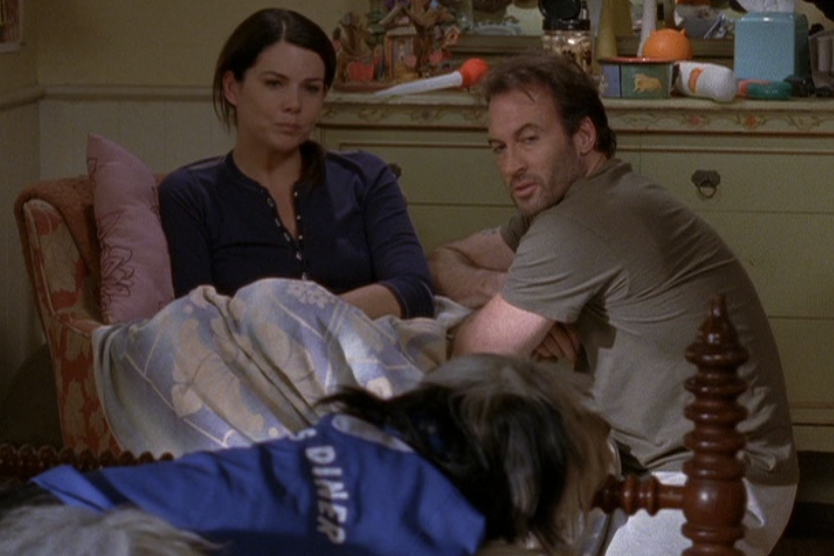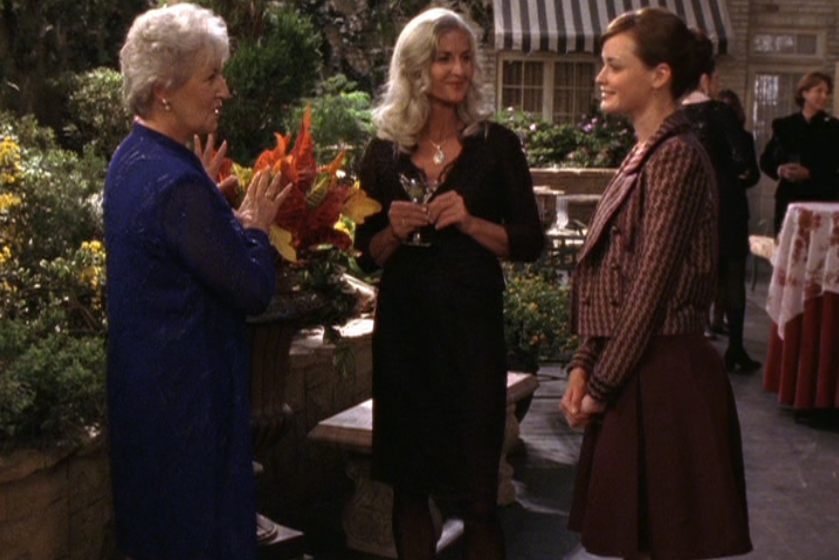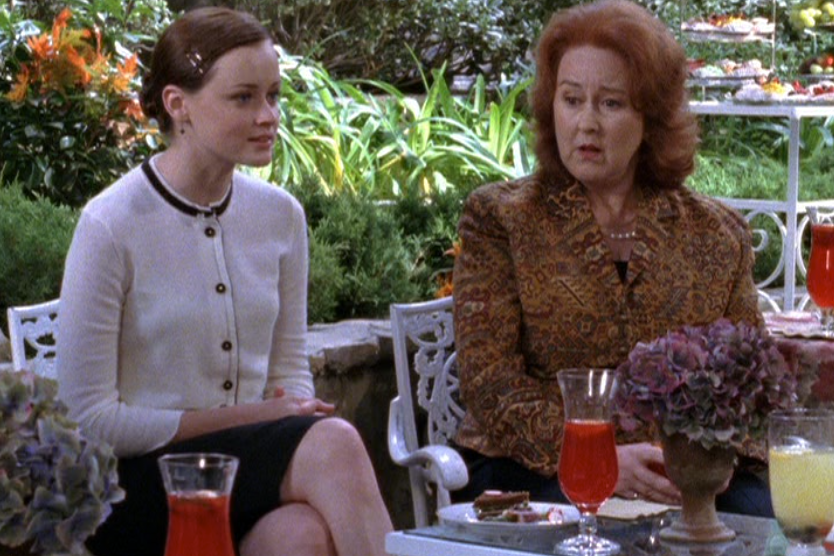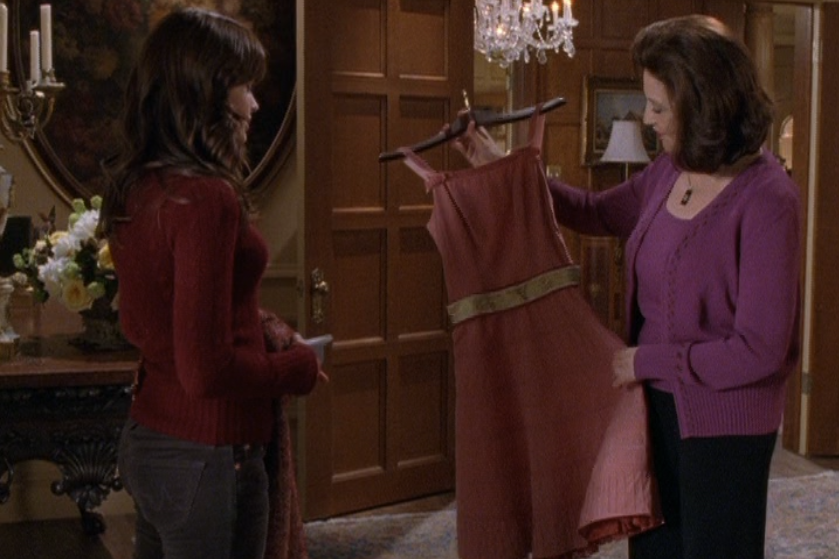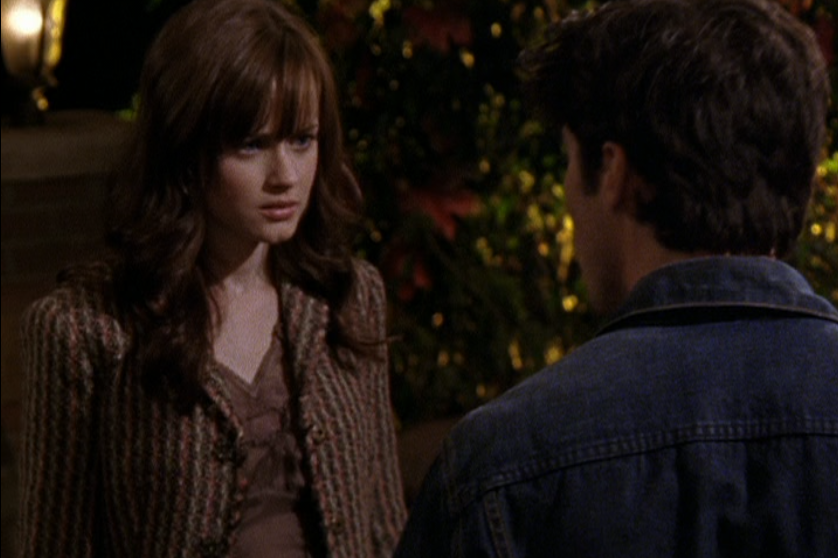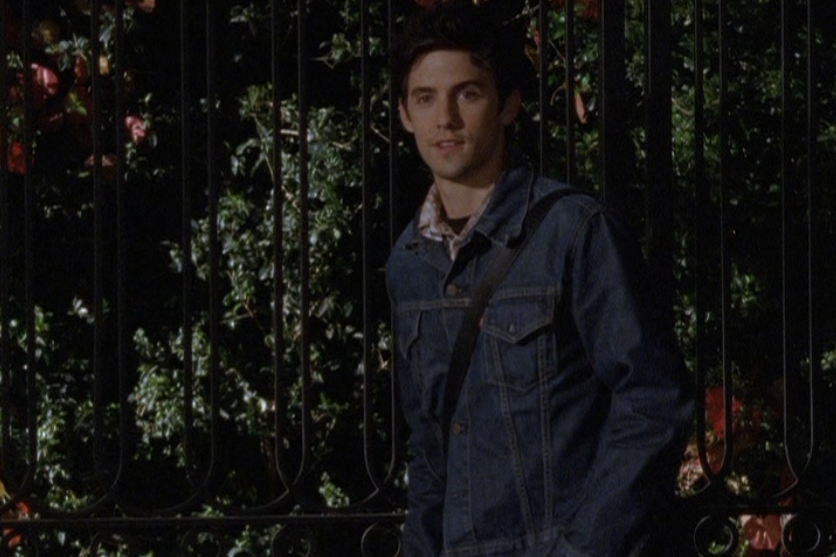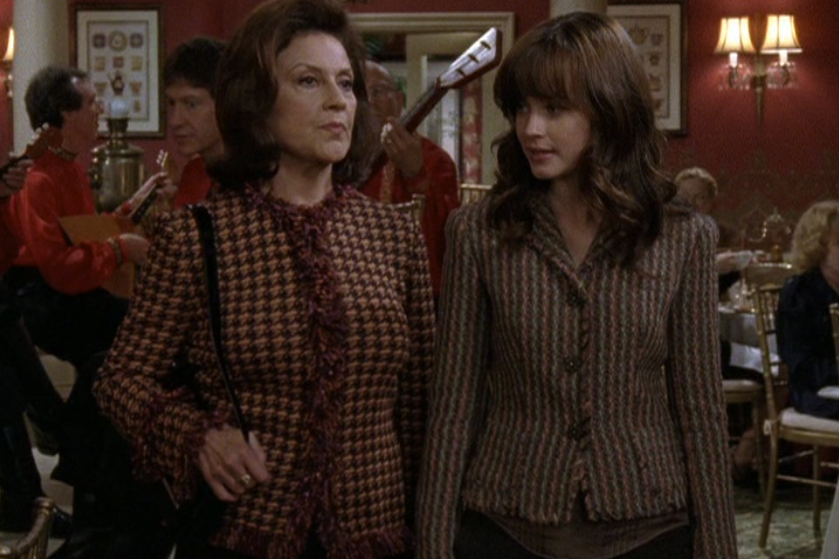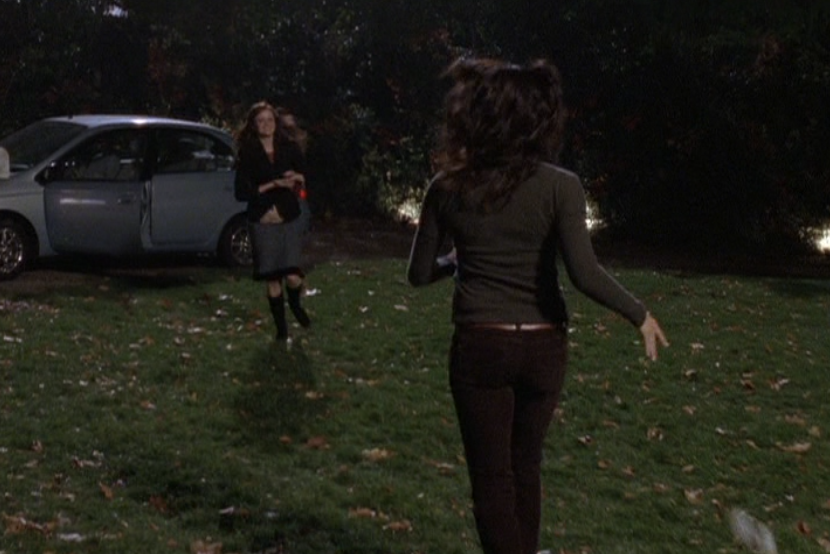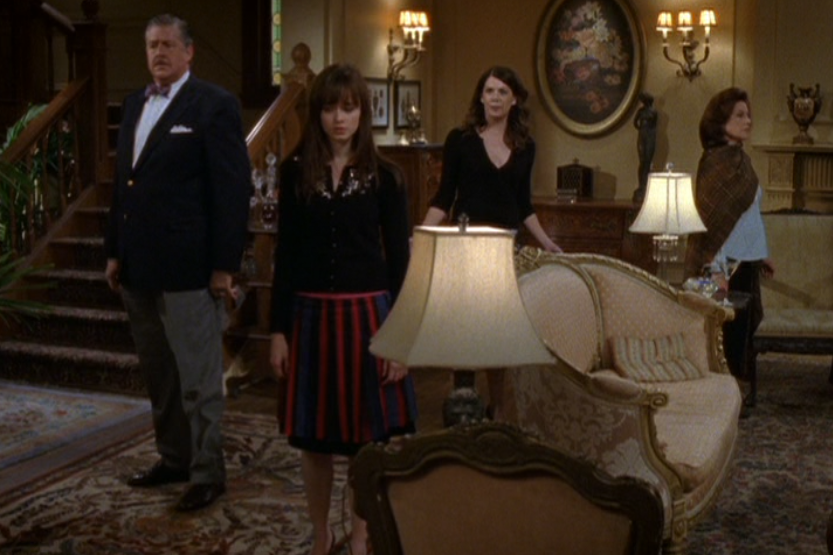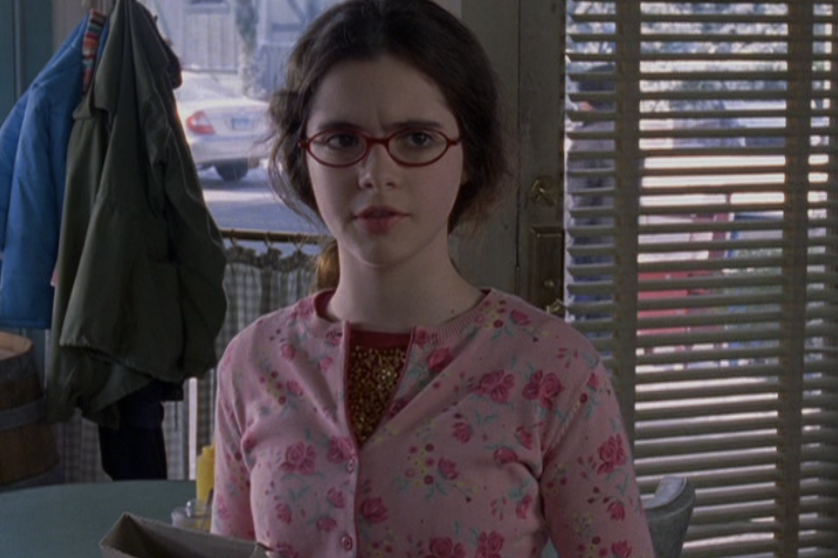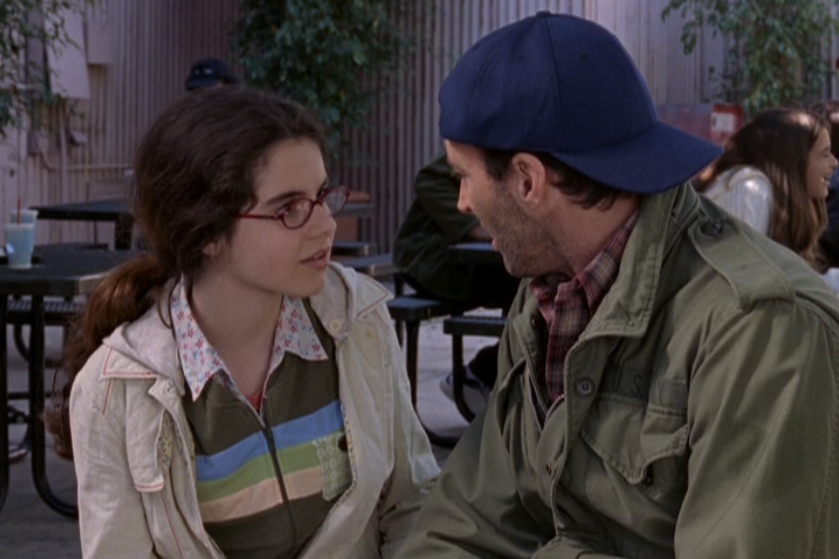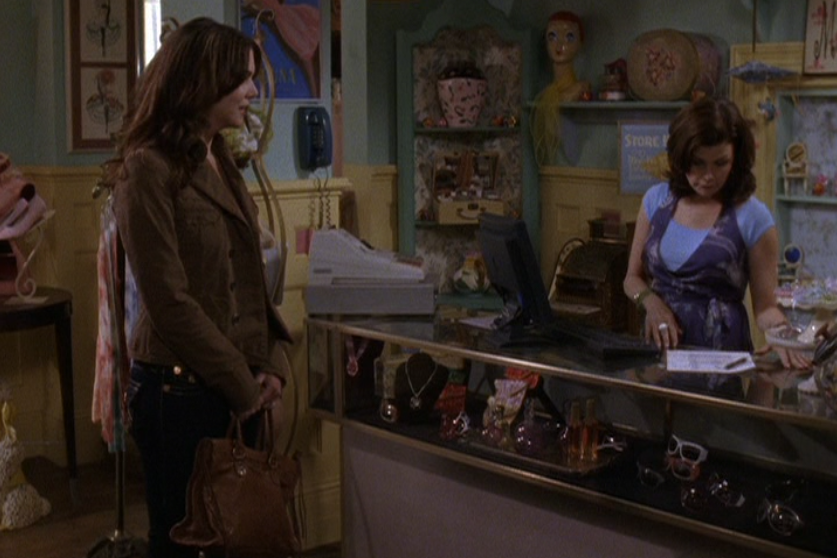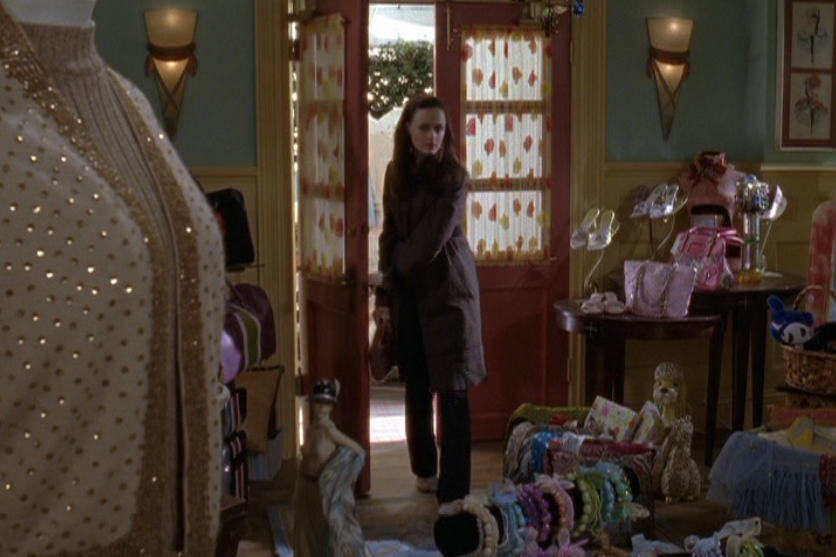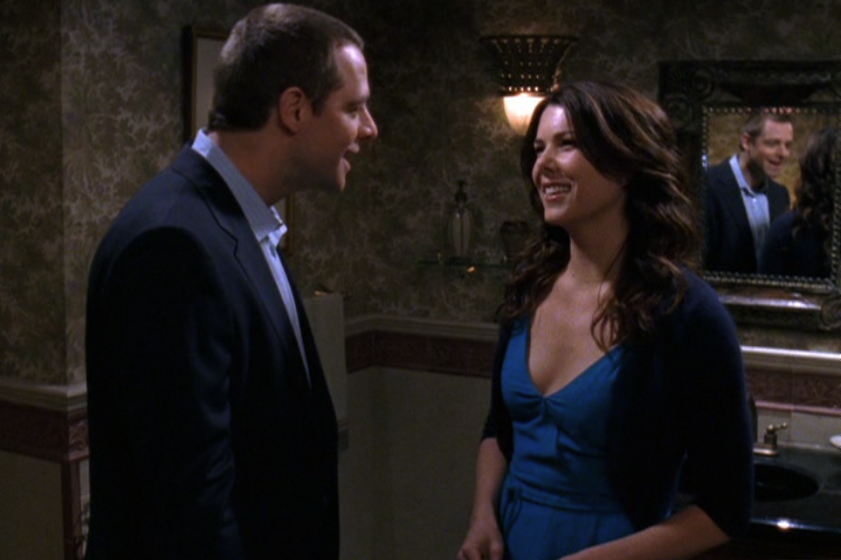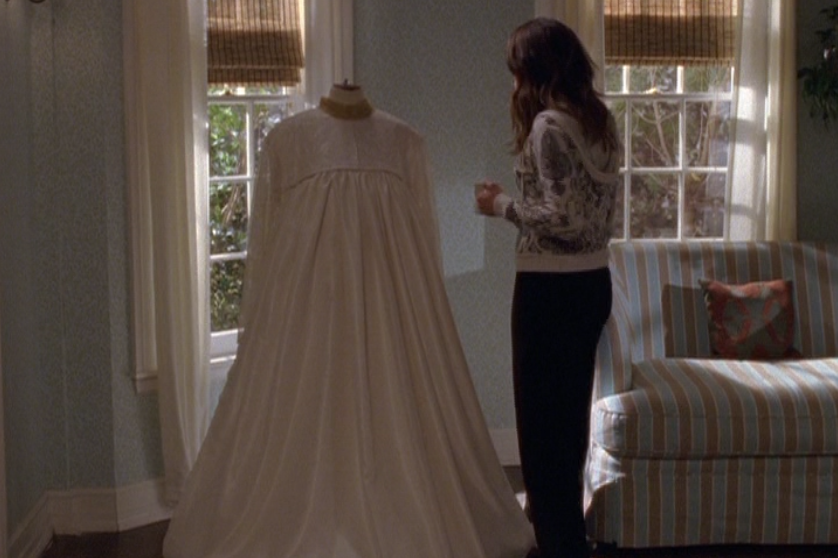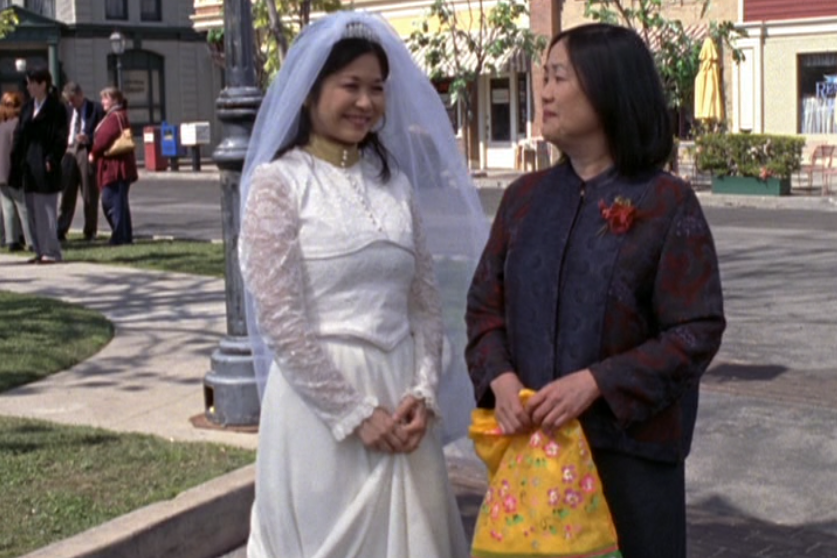“Which Goes Better with the Baby?”
Costume Design on Season Six of Gilmore Girls
Originally published on Letterdrop 11/10/2022
When I first watched season six, I kind of hated it. Like, not season-seven-this-dialogue-is-falling-flatter-than-a-bad-soufflé hated it, but I can’t say I liked it.
Lorelai and Rory not speaking? Preposterous! Luke hiding a long-lost daughter from Lorelai? Absurd! Christopher, full stop? Outrageous!! Now, I didn’t come around to every storytelling choice on my rewatch, but I did start to understand them. Lorelai, Rory, Luke—they’re all coming up against these long-held ideals of themselves and their relationships: What happens when you’re no longer who you thought you were? Can you help but collapse a little?
Rory and Paris (6.1)
A season ago, Rory was an intrepid reporter for the Yale Daily News, investigating one of Yale’s secret societies, the Life and Death Brigade. Then, its members looked at her with disdain, refused to answer her questions (5.7). Now, she’s one of them, down to the white cargo jacket that calls back to their Out of Africa costumes.
Yikes (6.1)
God knows the brigade loves an offensive costume: They throw her a party to celebrate her first felony, complete with black-and-white-striped prison suits (6.1). For the rich, white kids of the brigade, everything can be a joke because everything is without consequence. Emily and Richard have already hired a big-time lawyer for Rory; he expects she’ll get nothing more than twenty hours of community service.
Lorelai in 6.1
Even miles apart, Rory’s outfit is in conversation with Lorelai’s: Like her daughter, Lorelai wears a white jacket and top. Though Emily asks Lorelai to pack up Rory’s “good” clothes, Lorelai refuses to help. A season ago, she was the mother whose daughter told her everything, and vice versa; now, she wants to know nothing, say nothing. She doesn’t even tell Rory that she and Luke are newly engaged.
Note the sweet ribbon pattern (6.1)
Without additional clothes, Emily struggles to dress Rory for her court date. “It’s coming off a little more Mennonite than I hoped,” she says, fussing over Rory’s cardigan and blouse. When Rory is served three hundred hours of community service and a year’s probation, neither Emily nor Richard seem to grasp that their interference—fretting over Rory’s outfit, hiring a fancy lawyer—only enforced the judge’s assessment of their granddaughter as a “rich, privileged” child who needs “consequences.”
“I never should have let her go with a ponytail!” cries Emily.
Rory at orientation (6.2)
In episode two, Rory attends her community service orientation: again, likely dressed by Emily, in a prim blouse and headband. Outside of community service, Rory struggles to occupy herself, lounging around the pool house in a one-piece swimsuit and corduroy skirt, any plans to swim obviously forgotten.
I appreciate Rory’s commitment to a blue-and-green one-piece (6.2).
In the main house, Rory begins speaking with the Gilmores’ maid, Esperanza, in Spanish. When Emily arrives home, she’s disturbed to find Rory and Esperanza chatting and polishing silver. Emily, after all, only engages with her maids to reprimand them, never treats them as anything more than disposable.
Oop (6.2)
That evening, Emily and Richard summon Rory to discuss a part-time job. The Gilmores don’t want Rory spending time with maids—or, god forbid, becoming one, as Lorelai once did—so they must quickly manipulate her circle: finding her a job within their network of wealthy WASPs and replacing Esperanza with a Romanian maid, Draguta.
In her bathing suit and miniskirt, and now in her casual halter dress, Rory is the most exposed she’s ever been in the Gilmore mansion. Before she moved into the pool house, she never crossed the Gilmores’ threshold in anything less than her fancy dinner clothes or her Chilton uniform. Now, her grandparents are starting to see the reality of Rory living in the pool house—and the level of control they’ll need to exact.
And she indeed matches the drapes (6.3)
Emily finds Rory an office job with her chapter of the Daughters of the American Revolution. Like Emily, the DAR ladies are obsessed with appearance—seemingly the most important qualification for this position. “You’re going to match the drapes in our office perfectly,” one remarks; others compare Rory to a porcelain miniature. She might as well be porcelain: white and decorative, another object for the DAR office, alongside its antiques and portraits.
Rory’s fellow inductees are all Emily doppelgängers in their skirt suits and pearls (6.3).
To qualify for the position, Rory must become a DAR member—much to Emily’s delight. Rory is inducted in episode three: her hair swept back in a bun, her ears weighted with a large pair of diamond solitaires. Most importantly, her brown blazer is tweed, like many of Emily’s go-to jackets. Just as Emily styled Rory for her court appearance, she most surely dressed her for her DAR induction. Emily’s hand is everywhere, but Rory will only tolerate it for so long.
Lorelai and Rory (6.4)
When Rory dresses herself, she doesn’t think like Emily; she thinks like Lorelai. Sookie asks Lorelai and Rory to be her children’s godmothers, hoping the christening will reunite them. The morning of, Lorelai and Rory each ask their respective partners, Luke and Logan, which dress “goes better with the baby.”
Paul Anka is even lying on Rory’s childhood bed (6.8).
Without Rory, Lorelai unconsciously seeks out “children” to mother: She puts out elaborate spreads, reminiscent of the junk food feasts she and Rory used to consume, for the construction crew renovating her house. She adopts a dog, names him after a person (Paul Anka), and then caters to his neurotic needs. She even buys a dog-size jersey for the soccer team Luke is sponsoring (6.8), thus completing Paul Anka’s transformation from dog child to human child. Naturally, the jersey is Lorelai blue.
Emily must insist on pinned-back bangs for DAR functions (6.4).
As the season continues, Lorelai and Rory remain estranged, while Richard grows uncomfortable with Rory’s new life. She’s dressing more like Emily, spending more time on DAR work—even pulling off an impossible fundraiser in episode five.
Rory’s cardigan calls back to one of Emily’s many similar styles (6.5).
Richard has never respected Emily’s event planning, and so Rory’s newfound success disturbs him. Emily may worry that Rory will become Lorelai, but Richard worries Rory will become Emily.
Their black dresses remind me of Rory’s party dress from 5.8—the dress that started it all (6.7).
The ice between Rory and Lorelai starts to thaw in episode seven, when Rory invites Lorelai to her twenty-first birthday party: an elaborate affair planned, naturally, by Emily. Unlike at the christening, when Lorelai wore bright coral and Rory muted cream, both are in black dresses: each mourning the twenty-first birthday they’d once planned together, now replaced by lacy invitations and a sickeningly sweet signature cocktail.
Ultimately, it takes an unlikely (or perhaps, the most likely) person to snap Rory back to reality. In episode eight, Jess visits the Gilmore mansion. He’s recently published a novel with a small press in Philadelphia, and he wants to give Rory a copy. Just seeing Rory flip through Jess’s book sent a shock wave through my brain: We haven’t seen her reading since she moved into the pool house.
Emily shows Rory a dress for a DAR tea—note the little bows on the straps (6.8).
Jess quickly notices the changes in Rory’s clothes: When he sees a pink dress Emily picked out, he asks if it’s for Halloween.
The first night Rory sees Jess (6.8)
And the second (6.8)
Rory is still dressing in Emily tweed: On the first night he stops by, she’s wearing a red tweed peacoat. On the second night, when they go out for dinner with Logan, she’s yet again in the brown tweed blazer from her induction ceremony.
Jess on the first night (6.8)
And the second (6.8)
Jess looks more like the boy Rory knew in high school, not the leather-jacket-clad “bad boy” who left at the end of season three and returned briefly in season four. On the first night, he’s wearing a denim jacket, a variation on the fur-lined one he once owned; his shirt white plaid. (After all, he knew where to find Rory because Luke told him.) On the second night, Jess trades the white plaid for a light blue button-down. He’s now playing Lorelai: convincing Rory that she never should’ve dropped out of Yale.
I’ll leave Jess’s speech here, because it’s always worth a rewatch. Still, its most important message is already communicated through Jess’s familiar clothing: He knows Rory, and Rory knows him. He knew her when she dreamed of going to college and becoming a reporter; she knew him when everyone but her doubted him.
The fringe! It's like Emily’s tweed is growing more powerful (6.8).
Rory spends the night at Lane’s, then goes straight to a DAR tea in her brown tweed blazer. Emily, infuriated that she didn’t get to “inspect” Rory before the event, yells at her for not wearing the pink dress. Like Rory, Emily is wearing a tweed jacket: Though she has shaped her granddaughter in her image, she isn’t prepared to go toe to toe with her—or tweed to tweed. Rory is not interested in playing a sweet, young girl in a sweet, juvenile dress. She’s defiant, just like Lorelai was.
Pilot Inspektor Gilmore (6.9)
In episode nine, Rory moves out of the Gilmore mansion and into Lane’s apartment, and Emily spirals: Losing Rory feels like losing Lorelai all over again. When Lorelai finds her, Emily is considering buying a time-share of a plane. Like in episode 4.15, when she went on a frantic shopping spree, Emily is taking the worst ways people see her—as frivolous, useless—and turning them up to eleven. And yet, both she and Lorelai are wearing black pants and blue tops: They now share a common experience, losing a daughter—though Lorelai is quick to say that Emily never really “lost” her.
Reunited (6.9)!
After reenrolling at Yale, Rory returns to the Gilmore house, and her mother is ready to receive her. Lorelai is dressed more as she was in season one or two, in brown cords and a brown sweater—our girls close once again.
A return to Friday Night Dinner (6.13)
Rory and Lorelai rejoin Friday Night Dinner in episode thirteen, after Lorelai encourages Rory to repair her relationship with her grandparents. They’re dressed in black again, wary but formal as ever. Emily and Richard, however, are passive-aggressively casual: When they arrive, Richard is reading a book, and Emily is painting a moonscape for her DAR art class. She’s even wearing painting clothes, or what passes as painting clothes for Emily Gilmore: a brown plaid wrap over a light blue button-down and black slacks.
I feel this image spiritually (6.13).
I partly bring up this episode because it contains my favorite sequence in the series: the four Gilmores vacillating from heated arguing to hysterical laughter to appreciative silence. This Friday Night Dinner is the reset button to all Friday Night Dinners (and it devolves, as Emily and Lorelai’s fights always do, to Lorelai not marrying Christopher when she got pregnant). By the end, Lorelai and Rory are exhausted, their hair mussed and coats rumpled.
April in 6.9
With Rory’s return comes the other “prodigal daughter”: Luke’s twelve-year-old, April Nardini. His old girlfriend, Anna, never told Luke about her pregnancy; even April doesn’t know who her real father is: She appears in episode nine to collect Luke’s hair for her paternity-themed science project.
April’s cardigan reminds me of the many floral cardigans Rory wore in early seasons (6.12).
A super-smart only daughter of a single mother? Sounds kinda familiar. In fact, much of April’s costuming this season draws parallels between her and a younger Rory: Neither girl is particularly concerned with fashion, favoring practical pieces—turtleneck sweaters, cardigans, jeans, parkas—in looser silhouettes. The biggest difference is the color palette: While younger Rory favored orange, red, and olive green, April wears a lot of bright blue, purple, and pink.
Love their complementary coats and olive tones (6.18)
As Luke gets to know April, he delays telling Lorelai: first, because of Rory’s return; then, because of wedding planning. Still, I think Luke’s hesitance speaks to something deeper, a core-shaking crisis of self. To quote Rory, Luke is “Mr. Responsibility” (6.12), always there when the people he loves need him. Hell, he was more of a father to Rory than her own father was. But suddenly, through no choice of his own, Luke isn’t Mr. Responsibility anymore. He is—god forbid—Christopher.
Lorelai and Anna finally, briefly meet (6.20).
If April is Rory 2.0 and Luke is now Chris 2.0, then Anna is Lorelai 2.0. Like Lorelai, she’s a small business owner, a single mother. She’s even played by Sherilyn Fenn, who was almost cast as Lorelai and nearly went to series as another single mother, Sasha in Windward Circle. Side by side, Anna and Lorelai could be sisters—if they weren’t both only children.
The bracelets (6.17)!
Rory and Anna (6.17)
Both women favor quirky, patterned clothing—Anna’s wardrobe even a little more funky and casual than Lorelai’s. Her line of work allows for it: She runs a small boutique where she stocks “one-of-a-kind things,” from cheeky graphic Ts to the vintage Pan Am stewardess bag Rory picks up for Lorelai in episode seventeen. I even spy racks of plastic beaded bracelets, much like the ones Lorelai encouraged Emily to buy for Rory (1.6). Anna obviously has similar taste to Lorelai—in another life, they might even be friends.
But while Lorelai is eager to get to know April, Anna is cautious (6.20). She worries what will happen if Luke and Lorelai’s relationship isn’t so permanent. As a single mother, Lorelai can relate: Perhaps she remembers facing a similar dilemma with Rory and Max—worrying, like Anna, that her daughter will become too attached.
:(
):
After a season of wedding on and wedding off, Lorelai finally gives Luke an ultimatum: elope now or never (6.22). She’s in bright, declarative blue, putting her whole self on the table—but Luke, somber in solid gray, won’t agree to an elopement. She thinks he’s rejecting her; he thinks he needs more time to process.
That night, Lorelai goes to Chris—her once and always comfort person—so she won’t be “alone.” The next morning, she wakes up in his bed, her face passing into regret as she realizes where she is. Cut to black.
The man’s living room is even blue (6.19).
Now, I can’t say I’ll ever enjoy this twist. I actually find it—what’s the word—repulsive. But, as I said at the beginning of this post, I do understand it. While Luke descends, Chris ascends: He’s started paying Rory’s college tuition; he’s become a single father to his daughter with Sherry; he even attended Lane’s wedding with Lorelai when Luke was out of town. Now, does all that make up for twenty-odd years of flakiness? No, but it does give him a sheen of stability—a shot at becoming the new “Mr. Responsibility.”
Chris and Lorelai (6.22)
The night they sleep together, he’s even wearing a blue-striped shirt, picking up the blue in Lorelai’s dress. Indeed, in almost all their interactions this season, Chris has been wearing Lorelai blue. Lorelai may need someone to be there now, to want her now, but Chris has always wanted Lorelai.
The dress before (6.18)
Speaking of Lane’s wedding: She marries her bandmate Zach in episode nineteen—first in a Buddhist ceremony to please her grandmother, then in a Seventh-day Adventist ceremony to please her mother. For the latter, Lane wears Mrs. Kim’s old wedding dress, modernized through Lorelai’s alterations. The original dress was almost absurd in its modesty; according to Lane, it even had pants.
The dress after (6.19)
Lorelai rebuilds the garment into something still modest but more shapely: giving Lane “a waist” but preserving the dress’s beautiful gold collar. After the ceremony, Lorelai pulls off the long skirt to reveal a short skirt, sheer white tights, and a pair of white go-go boots: almost a reenactment of Lane’s teenage days, when she’d change into more fashionable clothes after leaving her house, then hand them off to Rory and Lorelai before she returned home.
Surprise (6.19)!
Later that night, Lane trades the gold collar for a pink one and the long veil for a short one (6.19).
And yet, the tearaway dress shows how much Lane—and Mrs. Kim—have grown. Mrs. Kim leaves after the ceremony, but not before she tells her daughter that she’s planning to put in earplugs and go to bed early. She knows Lane and her friends will have a raucous reception—and while Mrs. Kim may not want to attend it, she’s certainly not going to stop it.
Favorite Quote from Season Six
Every issue, I’m providing my favorite line(s) from that season. I’ll present this exchange, from 6.8, without further commentary:
Logan: So what are we talking here? Short novel? Kafka length or longer? Dos Passos? Tolstoy? Or longer? Robert Musil? Proust? I’m not throwing you with these names, am I?
Jess: You seem very obsessed with length.
The next and final issue on Gilmore Girls will drop on Thursday, 12/1. Yep, the final one: While I greatly appreciate everyone who expressed interest in a revival post and may still write one in the future, for now, I am pooped! I’ll touch on that a little more in my next post, but until then, thank you so much for following where I’ve led this volume. If you’ve enjoyed this post or the series so far, feel free to like, comment, or share.
Essential Episodes for Season Seven
7.3: “Lorelai’s First Cotillion”
7.8: “Introducing Lorelai Planetarium”
7.9: “Knit, People, Knit!”
7.17: “Gilmore Girls Only”
7.21: “Unto the Breach”

